Skin and Hair in Rheumatology

Dr.Nagnath Khadke
Rheumatological disorders are Auto-immune chronic disorders. One commonly equates most of these disorders as diseases related to joints. However in almost all of these disease various other systems are also involved, especially skin.
Systemic Lupus erythematosus, systemic sclerosis, sarcoidosis, vasculitis and myositis are few of the diseases where skin involvement is in fact one of the dominant systemic involvements. Many a times, skin manifestations can be the presenting symptom for rheumatological disorders. These skin manifestations often help in suspecting or sometimes even establishing a diagnosis.
Even though many of the skin manifestations can be similar across various diseases, not only rheumatological but infectious ones also, a simple procedure of skin biopsy and further investigations with histopathology (study of changes in tissues caused by disease) and immunohistochemistry (A laboratory method that uses antibodies) often clinches the diagnosis. This also helps in avoiding more invasive procedures sometimes required for establishing a diagnosis.
Skin also provides a reasonable window to the disease activity and involvement of other systems. Therefore improvement in the skin lesions can often co relate well with overall improvement in disease status.
As most of these diseases would always have a skin manifestation one way or the other, it would be prudent to consider those rheumatological conditions which are more common and which have dominant skin involvement.
We will start with Rheumatoid Arthritis.
Rheumatoid Arthritis –
Extra articular manifestation in RA, like skin involvement, usually co relates with the disease duration and severity. The various skin manifestations commonly observed in RA are, Rheumatoid Nodules, ( firm lumps under the skin). Pyoderma gangrenosum (large, painful sores (ulcers) that develop on your skin, most often on your legs)., cutaneous vasculitis (affecting small- or medium-sized vessels in the skin and subcutaneous tissue but not the internal organs.) ( perpura / gangrene ), erythema nodosum, (a type of skin inflammation that is located in a part of the fatty layer of skin) and livedo reticularis. (A netlike pattern of reddish-blue skin discoloration. The legs are often affected.).
Rheumatoid nodules most commonly develop in subcutaneous tissue and are firm, non tender and usually located in extensor surfaces (skin surfaces on the outside of a joint) and pressure points.

Pyoderma gangrenosum presents with single or multiple moderate to large painful ulcers mostly on lower limbs. They can be seen not only with RA but multiple other diseases like inflammatory bowel diseases, vasculitis syndromes (inflammation of the blood vessels) and sometimes hematological malignancies. (Hematological malignancies are cancers that begin in blood-forming tissue)

Perpura (a rash of purple spots on the skin caused by internal bleeding from small blood vessels), erythema nodosum (a type of skin inflammation) and livedo reticularis (is a skin symptom - a netlike pattern of reddish-blue skin discoloration) we will consider subsequently.
Psoriatic Arthritis –
Psoriasis is an auto immune chronic disorder which affects skin, scalp, nails as well as tendon attachment sites and joints. In most of the cases ( 75 % ), skin condition precedes arthritis, in 15 % it develops after arthritis and in 10 % cases the skin and joint involvement occurs simultaneously. Majority of the psoriasis patients develop arthritis after 5 to 15 years of skin involvement.
Joint involvement without skin involvement is termed as “ Psoriatic Arthritis sine Psoriasis “, and can be difficult to diagnose early.
Psoriasis has different morphological patterns, Plaque psoriasis, Guttate psoriasis, pustular psoriasis and inverse psoriasis.
Psoriasis can involve nails with, nail pitting , onchylosis ( detachment of nail plate from nail bed ), onchymadesis ( shedding of the nail ), trachyonychia (is a disorder of the nail) , subungual hyperkeratosis (Thickened, discolored skin under nail) , splinter haemorrhagesor discoloration of nail bed.
Psoriatic arthritis commonly involves DIP joints along with other small joints of hands and feet. Psoriatic arthritis can lead to a rapidly progressive aggressive joint inflammation causing complete destruction and deformities of the joints, called as, Arthritis Mutilans.



Reactive Arthritis –
Reactive Arthritis is a form of spondyloarthritis characterized by inflammatory joint, skin and eye involvement that develops after gastrointestinal or urogenital infection, though the infection is not often documented in all cases.
The cutaneous manifestations are distinctive enough to differentiate it from other similar arthritides and are seen in up to 15 % of cases.
Typical cutaneous features of reactive arthritis includes, Keratodermablennorrhagicum,circinate balanitis / vulvitis and keratotic plaques.
Keratodermablennorhagicum is a symmetric involvement of palms and soles in the form of keratotic erythematous pappules, pustules or plaques. These are morphologically and histologically indistinguishable from psoriatic lesions.

Reactive arthritis also involves nail in similar fashion to psoriatic arthritis with pitting, onchylosisanssubungual keratosis.
Circinte balanitis or vulvitis are erythema or plaque like lesions on the shaft or glans of penis or labia.


IBD relate arthritis
Common mucocutaneous manifestations in IBD related arthritis are Erythema nodosum, pyodermagangerenosum, sweet syndrome and apthous stomatitis.
Systemic lupus erythematosus
Of all the auto immune diseases, SLE, is perhaps most well-known for muco-cutaneous involvement.
SLE has quite extensive and myriad skin manifestations of which some are SLE specific and some are SLE non specific. SLE non specific skin manifestations can be seen in many other auto immune as well as non auto-immune diseases. These are palpable perpura, urticarial vasculitis, livedoreticularis, Raynaud’s phenomenon, erythema multiforme, periungualtelangiectasia. SLE can also produce skin lesions similar skin lesions seen in auto immune skin disorders like lichen planus, pemphigus and dermatitis herpetoformis.
Systemic lupus erythematosus
Of all the auto immune diseases, SLE, is perhaps most well-known for muco-cutaneous involvement.
SLE has quite extensive and myriad skin manifestations of which some are SLE specific and some are SLE non specific. SLE non specific skin manifestations can be seen in many other auto immune as well as non auto-immune diseases. These are palpable perpura, urticarial vasculitis, livedoreticularis, Raynaud’s phenomenon, erythema multiforme, periungualtelangiectasia. SLE can also produce skin lesions similar skin lesions seen in auto immune skin disorders like lichen planus, pemphigus and dermatitis herpetoformis.
Lupus specific skin lesions –
Acute cutaneous lupus – localized or generalized
Sub acute cutaneous lupus – annular or pappulo-squamous
Chronic cutaneous lupus – discoid lupus erythematosus, lupus panniculitis, lupus tumidus and chillbains lupus.
Malar rash –
It’s a classic butterfly rash presenting as erythematous pruritic pappular lesions commonly developing in malar distribution and mostly precipitated by sun light exposure is perhaps the most well knownrheumatological rash. It can be a presenting symptom many times and is present in large proportion, up to 60% to 90 % of SLE patients at some point of time. It also is a part of classification criteria. Common differentials include acne rosacea, seborrheic, atopic or atopic dermatitis.

Sub acute cutaneous lupus –
these rashes usually start as small erythematous slightly scaly lesions which evolve in to either psoriasiform or annular form. These are hard to differentiate from psoriatic skin lesions. These are highly photosensitive lesions.
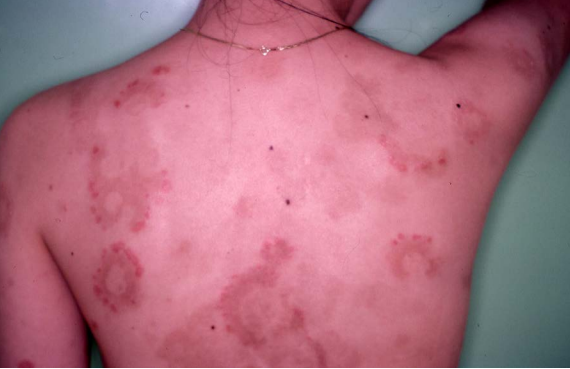
Discoid lupus –
These are discrete erythematous plaque like lesions which slowly expand and resolve with central area of clearing with scarring, atrophy and depigmentation.
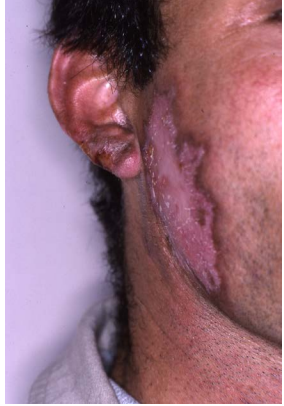
Lupus panniculitis –
These are firm, nodular, often tender lesions which can develop at any site and usually resolve leaving depressed area.
Photosensitivity –
Photosensitivity is extremely common in lupus patients, present in 60 % to 100 % of patients, who tend to develop a rash on exposure to sunlight, which contains UV-B radiation. Rarely patients can also be sensitive to radiation of common house lights / bulbs or visible light spectrum.
Idiopathic inflammatory myositis –
These are a group of auto immune chronic diseases primarily having inflammatory muscle involvement, although skin, lung, and joints can also be involved in large number of patients. They are further classified in to Polymyositis, Dermatomyositis, Inclusion body myositis and miscellaneous myositis.
Skin is most commonly involved in “ Dermatomyositis “ in which certain specific skin lesions are a disease defining criteria. These cutaneous lesions may precede muscle symptoms by months or years. Most of these skin lesions are pathognomic or charecteristic and include Gottron papule, gottron sign, heliotrope rash, mechanic’s hands, shawl sign, “V” sign, holster sign etc..
Gottron sign is a symmetric violaceous or erythematous plaques or atrophic macules over bone prominences like knucles, elbows or malleoli.
Gottronpappules are violaceous round flat topped papules with slight central depression, and are most commonly seen on knuckles, toes or elbows.
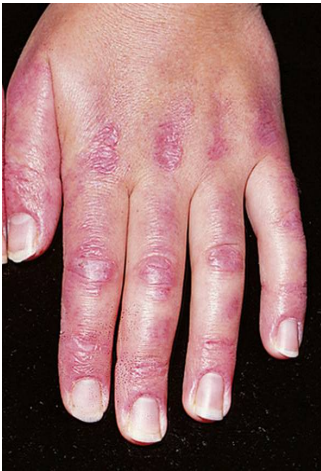
Heliotrope rash is violaceoussymmetric hue of the eyelids and peri orbital region with associated oedema. This can be an early finding lasting for long time, however the colour fades away and oedema subsides with immunomodulation theorapy.
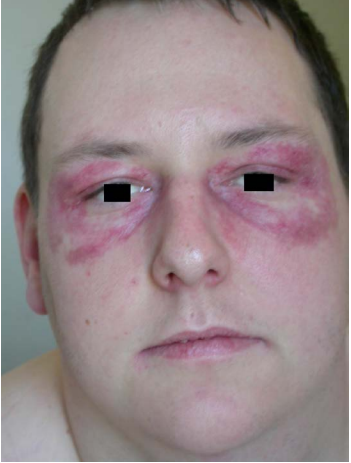
Shawl sign, V sign and holster sign are confluent violaceous macular erythema distributed over upper back and neck ( shawl sign ), front of the neck and chest ( V sign ) and lateral aspect of thighs and buttocks ( holster sign ). With treatment these rashes heal with patchy depigmentation. If the lesions progress to ulceration, it is a poor prognostic sign.


Mechanic’s hands are hyperkeratotic, scaly, hyperpigmented, fissuring, symmetric and non pruritic lesions over thumd, index and middle fingers. These are commonly present with anti synthetase syndrome.
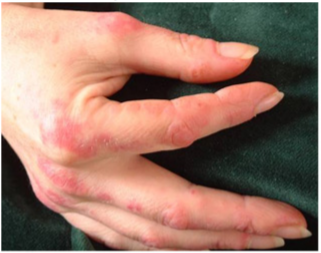
Telangiectasia, livedoreticularis, Raynaud’s phenomenon are some of the types of skin lesions some times observed in Myositis.
Systemic Sclerosis –
Also known as scleroderma, this is a chronic auto immune disease with pathognomic involvement of the skin. In fact this is one rheumatological disorder where the skin involvement in itself is enough for establishing diagnosis The manifestations can range from primary skin involvement to significant systemic involvement.
Scleroderma –
This is a symmetric thickening, tightening and induration of the skin.
If limited to area distal to MCP joints and face, it is called as limited sclerosis and if it extends to area proximal to this joints and other body parts, it is called as diffuse scleroderma.
Skin changes evolve through three sequential phases.
First and earliest phase is oedematous phase characterized by puffiness , swelling and decreased flexibility of the face, fingers and hands. In the second phase there is progressive induration causing gradual diffuse sclerosis. The affected skin appears shiny, taut, thickened and bound down leading to a pinched nose, loss of wrinkles over face and mask like face. Eye lid retraction is difficult. In the final phase which develops after many years, skin becomes thin, atrophic and tightly tethered to underlying tissue. In severe cases, finger contraction or ulcers on bony prominences can also develop leading to functional disability.
Raynaud’s phenomenon –
It is one of the earliest symptom of scleroderma seen in fingers, toes, ears and nose. It presents with sequential changes in skin colour from pallor followed by cyanosis ending with rubor as reperfusion occurs.

Salt and pepper skin rash –
Skin thickening is usually accompanied with pigementary changes. Salt and papper appearance is commonly observed over forehead, neck, chest and upper back.
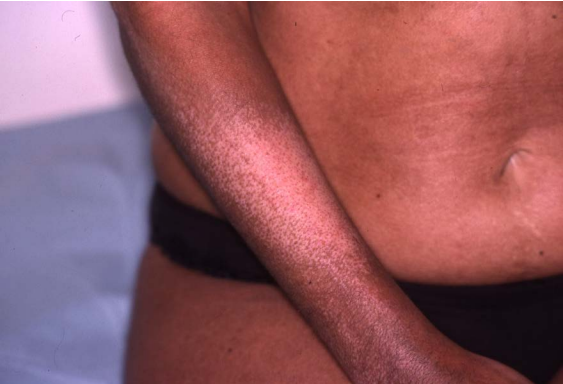
Digital Ulcers –
Though a skin finding, the cause for these ulcers which develop at finger tips is vascular involvement. These occur due to chronic ischemia, can lead to secondary infection and are slow to heal. Up to 25 % of such ulcers may progress to gangrene and auto amputation.
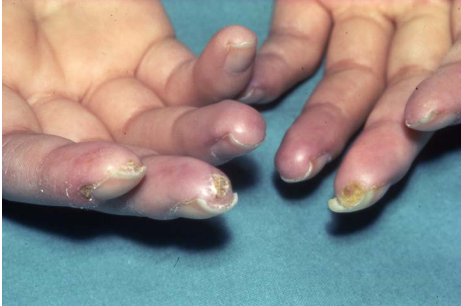
Telangiectasia –
These are erythematous matted skin lesions of vascular origin which blanch on pressure. They primarily develop on palms, face, oral mucosa. They are indicative of ongoing vascular injury and are associated with increased risk of pulmonary hypertension.

Calcinosis –
These are deposits of calcium phosphate in soft tissues which can be visible to naked eye. They can occur at any site and are painful, hard and adherent to underlying tissue with infection or fistulization as possible complication.

Skin manifestations in systemic vasculitis
Palpable perpura –
Unquestionable one of the commonest manaifestation which begin as tiny macular erythematous lesions progressing to becomes papules or plaques. It is most common in legs, ankle and feet.
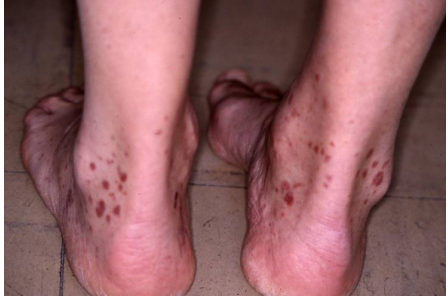
Urticarial vasculitis –
Unlike ordinary urticarial which usually resolves in 24 hours, the urticarial vasculitis, characterized by wheals, persists 2-3 days

Nodular vasculitis –
Nodules in vasculitis are typically observed in lower limbs, and are typically small hard tender and inflammatory.
Livedoreticularis –
It’s a reddish blue mottling of the skin in retiucalar pattern. It can be seen in various connective tissue diseases as well and can be differentiated by morphological variations in pattern.

Necrosis, gangrene, pyodermagangerenosum, superficial thrombophlebitis, granuloma and panniculitis are some of the other common skin manifestations that can be observed in different systemic vasculitis.
Erythema nodosum –
It’s a very common skin lesions across inflammatory arthritis, connective tissue disease and vasculitis. It is usually sudden in onset and common over lower limbs. It presents as single or multiple firm tender subcutaneous nodular lesions. They usually resolves within days or weeks, without scar formation.

Behcets disease.
Complex aphthosis is the mucosal hallmark of the disease and are presenting symptom in 25-75 % cases. These are mostly recurrent. They are usually difficult to distinguish from the ordinary oral ulcers. Sometimes they are herpetiform. Genital ulcers are seen in 60-80 % cases.

Pseudo-folliculitis, observed in 40-60 % cases, and is commonly seen on trunk, limbs, buttocks and genitals. It is non follicular erythematous papule that becomes pustular and either resolves or ulcerates.

Various nodules which are erythema nodosum like also occur in behcets disease.
skin involvement due to cutaneous drug toxicity
while skin involvement is extremely common because of various diseases, one cannot neglect the possible skin involvement as a side effect of various drugs used in treatment of such diseases.
Non steroidalanti inflammatory drugs
NSAIDs can cause allergic reactions ranging from transient skin rash to extremely fatal conditions of stevens Johnson syndrome or Toxic epidermal necrolysis.
Sulphasalazine
It can cause transient pruritic skin rash which usually resolves after stopping drug. However it can cause a peculiar hypersensitivity syndrome with lichenoid skin eruptions or sometimes TEN or SJS. Sulphasalazine also causes orange discolouration of the sweat.
Hydroxychloroquine
it can commonly cause pruritis, increased photosensitivity and characteristic greyish blue discolouration of skin. These drugs are contra indicated in psoriasis as they can exacerbate skin psoriasis as well as psoriatic arthritis.
Methotrexate
Skin toxicity is rare but it can sometimes cause paradoxical worsening of rheumatoid nodules.
Leflunomide
Allergic skin rash and alopecia are possible side effects.
Glucocorticoids
Glucocorticoids ( steroids in common tongue ) have numerous side effects which are seen with long term use. Common side effects on skin are striae formations or thinning of skin, which can lead to recurrent perpura or ecchymosis.
Biologic drug treatment
Though biologic drugs have less systemic side effects, rarely they can cause certain skin related side effects.
Anti TNF agents can cause psoriasiform lesions, sometimes immediately after first dose or sometimes several months later. In such a scenario the drug needs to be switched or stopped and rarely treatment for psoriasis can be required.
These injections can also cause localized skin eruptions resembling eczema or atopic dermatitis.
Hair involvement
Diffuse alopecia is very common but non specific in SLE. It commonly happens during active disease phase and recovers as the disease activity settles down. However the new hair are fine and slow to grow.
Scarring alopecia, common in discoid lupus is specific for SLE. It is permanent in nature.

Diffuse alopecia is also common during active phase of various connective tissue disease and vasculitic diseases. It can usually recover with settling of disease activity.
Diffuse alopecia is also possible with certain drugs which are commonly used in treatment of rheumatic diseases. The most common culprits are cyclophosphamide, leflunomide and methotrexate.
Do’s and Don’ts for patients
- Never neglect a skin lesions and immediately report it to your rheumatologist
- A new skin lesion development should be taken seriously as it may denote an entire new disease condition, change in disease activity or possible side effect of the ongoing medications.
- Skin biopsy is a minor procedure and does not disfigure your skin. Moreover it is better than other invasive diagnostic procedures.
- Photosensitivity is common and can be easily managed with sun protecting topical agents with high SPF ( sun protection factor )
- Skin and hair related side effects of anti rheumatoid medication, though common, are not permanent and usually resolve completely with stopping of the drug.
- Following proper treatment as advised by your rheumatologist is a good way to protect your skin and hair, from disease as well as drug related effects.
































